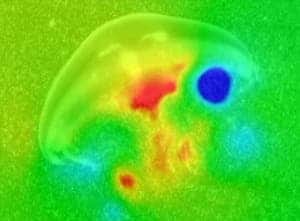Jellyfish are really impressive creatures, for all their simplicity; now, a new research has shown that the elastic body allows moon jellyfish to travel extra distance at no energy cost.

(c) BRAD GEMMELL
The sockeye salmon is a sleek, muscular torpedo which rams up waterfalls. The jellyfish is a blob, drifting on aimlessly in the oceans. Obviously, the salmon is the more powerful swimmer, but as it turns out, the jellyfish outclasses it in terms of efficiency – it outclasses everybody, for that matter. For its mass, the jellyfish spends less energy to travel a given distance than any other animal in the world.
Brad Gemmell at the Marine Biological Laboratory in Woods Hole, Massachusetts, has found that for all its lack of brain, the jellyfish is incredibly well adapted to its environment; it has a unique technique through which it recaptures some of the energy spent on each swimming ‘stroke’, giving itself an extra push without any cost, travelling further without any additional effort.
He first started studying the jellyfish as part of a US Navy-funded project to look at unusual methods of locomotion in marine animals. As he was analyzing their movements, he found something suspicious – sometimes, even when their bodies were perfectly still, they still picked up speed. This was so strange that he first discarded it as a measurement error.
“We first discounted these blips, but every species and every run we looked at had them,” he says. “They clearly weren’t noise in the data.”
To further study this speed boost, he paralyzed the jellyfish with magnesium chloride solution, which blocks nerve signals from reaching their swimming muscles. He then pushed them around with a rod to see how water moves around them.
What he found was that when the jellyfish contract their umbrella-like bells, they create two vortex rings – two “doughnuts” of water which spin onto themselves; the jellyfish initially propels itself by shedding the first ring, which is normal and not unusual. But as the bell relaxes, the second vortex of water spins faster and moves in, pushing up against the centre of the jellyfish and giving it a secondary boost, propelling the jellyfish “an extra mile” (see video above). The bell is so elastic that it relaxes automatically, which means that the extra boost comes at no extra energy cost.
These results contradict the typical view of jellyfish as inefficient swimmers, and with further studies and experiments, they could be applied for man-made vehicles as well.
“You could deploy them for longer without extra batteries, size or maintenance,” he says.
Source: Nature doi:10.1038/nature.2013.13895






